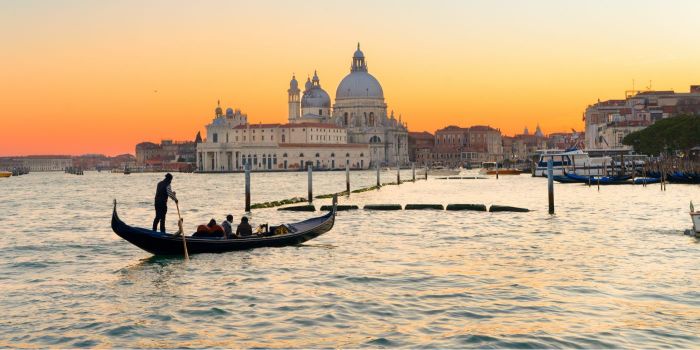Doge's Palace in Venice: A Dive into the History of the Serenissima
Doge Palace: the tickets most chosen by travelers
Discover the Doge's Palace: The Unmissable Attraction of Historic Venice
The Doge's Palace in Venice is one of the city's most iconic monuments, representing an extraordinary blend of art, history, and politics. Located in St. Mark's Square, this building was constructed in the 14th century in Venetian Gothic style, with later Renaissance and Baroque additions. It was the official residence of the doges, the governors of Venice, and housed the main governmental institutions of the Serenissima Republic, such as the Great Council, the Senate, and the courts.
Originally conceived as a fortress, the palace underwent numerous expansions and renovations to adapt to the political and administrative needs of the Republic. Its strategic position on the Grand Canal made it both a defensive stronghold and a symbol of Venice's power and prosperity. In the Middle Ages, Venice was one of the richest and most powerful cities in Europe, with a trade network extending as far as the East.
One reason the Doge's Palace is so unique is its architectural structure. The wide portico on the ground floor and the loggias on the first floor create a delicate and airy visual balance, contrasting with the solid upper structure of the building. This architectural solution was innovative for its time and represents the elegance and boldness of Venetian culture.
The Doge's Palace also houses masterpieces of Renaissance and Baroque art. Many of its interiors are decorated by renowned artists, including Tintoretto, Veronese, and Tiziano, who created frescoes and paintings to glorify the Republic of Venice. Notably, the Hall of the Great Council, one of the largest in Europe, is adorned with Tintoretto's famous cycle of paintings that depicts episodes from Venetian history and the Republic.
During its golden age, the Palace was also a place where justice was administered. Secret passages and corridors connected it to the prisons in the neighboring building. The famous Bridge of Sighs allowed condemned prisoners to see the sky and lagoon for the last time, in a poignant contrast between lost freedom and the beauty of Venice. This physical and symbolic connection between power and justice remains a fascinating aspect of the visit to this day.
Visiting the Doge's Palace means not only admiring an architectural and artistic masterpiece but also immersing oneself in the most captivating part of Venice, uncovering tales of intrigue, conspiracies, and revolts that marked the centuries of the Republic's rule. These stories explain how this city became a maritime and cultural powerhouse for nearly a millennium.

Discover all other experiences
Useful Information for Visiting the Doge’s Palace
By purchasing a ticket for the Doge's Palace, you gain access to a comprehensive cultural experience that not only includes a visit to the palace itself but also covers other attractions in St. Mark's Square. This combined ticket is ideal for those wishing to fully immerse themselves in Venetian history and art. Here’s what’s included:
-Guided tour of the Correr Museum, National Archaeological Museum, and Monumental Halls of the National Library of St. Mark’s.
Doge Palace: tips for your visit
How to Get to the Doge's Palace
Palazzo Ducale is located in Piazza San Marco and is easily accessible by various means:
-On foot: From any point in the historic center, Piazza San Marco is well-signposted and can be reached on foot in about 20-30 minutes from the train station.
-By vaporetto: Vaporetto lines 1 and 2 (Venice's public water transport) take you to the San Zaccaria stop, just a few minutes' walk from Palazzo Ducale.
-From Venice Marco Polo airport: There are direct connections via the Alilaguna water transport service, with stops at San Marco, passing through Murano and Fondamenta Nove.
The best experiences in Venice
Best attractions around Doge Palace
all entrance tickets for the most popular Italian attractions
Venice Gondola Rides
VeniceSt. Mark's Basilica
VeniceJuliet's House
VenetoVivaldi Concert Venice
VeniceGondola Ride
VenicePeggy Guggenheim Collection
VeniceVerona Arena
VenetoDoge's Palace in Venice: your updated guide to the gothic jewel of the city
A true masterpiece of Venetian Gothic architecture shines in St. Mark's Square: discover here our tips on how to visit the Doge's Palace in Venice!
Read more
Frequently Asked Questions About Visiting the Doge’s Palace
1. How long does a visit to the Doge's Palace take?
A guided tour of just the Palace usually takes about an hour, while a full exploration of various areas, including the institutional halls and prisons, requires around 2-3 hours.
2. Is the Palace accessible?
Yes, the Doge's Palace is fully wheelchair accessible.
3. Does the ticket allow you to skip the line?
Yes, this ticket includes a "Skip the Line" feature.
4. Are there discounts on tickets?
Discounted tickets are available for infants (0-5), children (6-14), students (15-25), and seniors (65+).
5. Is the ticket refundable?
You can receive a full refund if you choose a refundable ticket during checkout and cancel by 11:59 pm the day before your visit.
6. What attractions are included in the ticket?
The Doge's Palace ticket also includes access to the Correr Museum, the National Archaeological Museum, and the Monumental Halls of the National Library of St. Mark's in St. Mark's Square. Some tickets also offer the opportunity to take the "Secret Itineraries" tour, a guided visit to the hidden areas of the palace.
7. Is it necessary to book the entrance?
Reservations are not mandatory but are highly recommended to avoid lines, especially during the peak tourist season.
How to Visit the Doge’s Palace
Visiting the Doge’s Palace allows you to immerse yourself in the history, art, and culture of Venice. Located in St. Mark’s Square, the palace is easily accessible, and planning your visit in advance makes the experience even more enjoyable. The palace is open from Tuesday to Sunday, from 9:00 am to 6:00 pm, with the last entry at 5:00 pm. It is highly recommended to buy tickets online to avoid long lines, especially during peak season. The standard ticket includes access to the Doge’s Palace, the Bridge of Sighs, the Armory, and some nearby museums, such as the Correr Museum, the National Archaeological Museum, and the Monumental Halls of the National Library of St. Mark’s. Those seeking a more in-depth experience can join the “Secret Itineraries” tour (available for an additional fee), which allows access to hidden areas of the palace, including the Torture Chamber and the Hall of the Inquisitors. A complete visit to the palace typically takes 2-3 hours, though the duration may vary depending on the type of tour selected.
Curiosities about the Doge’s Palace
The Porta della Carta: The main entrance to the palace, known as the Porta della Carta, is a Gothic masterpiece adorned with intricate sculptures that depict symbolic scenes. It was created by Giovanni and Bartolomeo Bon in the 15th century and served as a symbolic link between the Palace and St. Mark’s Basilica.
The Bridge of Sighs: One of the palace’s most famous features, the Bridge of Sighs connects the Doge’s Palace to the prisons. The name derives from the legend that prisoners would sigh upon seeing the lagoon for the last time before their confinement.
Tintoretto and Veronese: The palace houses masterpieces by renowned Venetian artists, including Tintoretto and Veronese. Their works adorn many of the institutional halls, depicting episodes from the history of the Republic of Venice and creating a unique and symbolically rich environment.
The Role of the Doge: The Doge’s Palace was the official residence of the Doge of Venice, the head of the Republic. The Doge lived within the palace under strict limitations: he could not leave Venice without the Council’s permission, and his life was closely monitored.
The Secret Itineraries: The “Secret Itineraries” tour includes areas rarely accessible to the public. These include the prisons, the Office of the Secret Chancellery, and the Torture Chamber. These rooms are connected by hidden passages once used for security and political control.
Symbol of the Serenissima: Built as a symbol of the power and prosperity of the Serenissima Republic, the palace is also an expression of Venetian architectural excellence. Its unique structure, with open porticoes on the lower level and loggias above, creates a light and airy visual effect that contrasts with the solidity of the upper floors.






























Marika Camposano
The Doge's Palace in Venice, in St. Mark's Square, is one of the city's most iconic attractions, symbolizing the power and culture of the Serenissima Republic. Once the Doge's residence and political center, it offers visitors a chance to admire Gothic architecture, Renaissance and Baroque artworks.